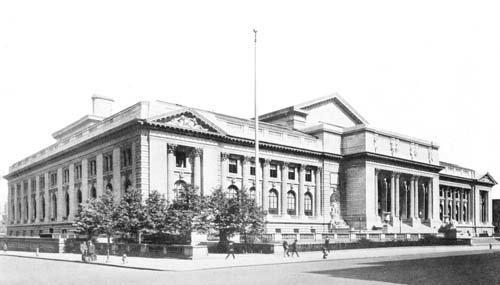 CENTRAL BUILDING
CENTRAL BUILDINGTHE NEW YORK PUBLIC LIBRARY
The Project Gutenberg EBook of Handbook of The New York Public Library, by New York Public Library This eBook is for the use of anyone anywhere at no cost and with almost no restrictions whatsoever. You may copy it, give it away or re-use it under the terms of the Project Gutenberg License included with this eBook or online at www.gutenberg.org Title: Handbook of The New York Public Library Author: New York Public Library Release Date: January 31, 2009 [EBook #27954] Language: English Character set encoding: ISO-8859-1 *** START OF THIS PROJECT GUTENBERG EBOOK HANDBOOK--NEW YORK PUBLIC LIBRARY *** Produced by Carla Foust, and The Online Distributed Proofreading Team at https://www.pgdp.net (This file was produced from images generously made available by The Internet Archive/American Libraries.)
Minor punctuation errors have been changed without notice. In this version on pages 74-75 are diagrams of floor plans. Clicking on these images will show you larger versions.
 CENTRAL BUILDING
CENTRAL BUILDING1916
Copyright, 1916, by
The New York Public Library
| The Central Building: | PAGE | |
| Exterior | 7 | |
| Sculpture | 13 | |
| The rear of the Building | 15 | |
FIRST FLOOR
| Entrances | 17 |
| Elevators | 19 |
| Exhibition Room | 19 |
| Current Periodicals Room | 19 |
| Business Offices | 21 |
| Technology Division | 21 |
| Patents Room | 22 |
| The Library for the Blind | 22 |
SECOND FLOOR
| Oriental Division | 23 |
| Jewish Division | 23 |
| Slavonic Division | 23 |
| Science Division | 25 |
| Economics Division | 25 |
| Business Offices | 25 |
THIRD FLOOR
| Public Catalogue Room | 27 |
| Information Desk | 31 |
| Application for Books | 31 |
| The Main Reading Room | 31 |
| The Library's Books | 33 |
| Use of Books | 39 |
| Stack | 39 |
| Genealogy Room | 39 |
| American History Division | 39 |
| Reserve Books | 41 |
| Prints Room | 43 |
| Art and Architecture | 43 |
| Map Room | 45 |
| Stuart Gallery | 45 |
| General Gallery | 45 |
| Prints Gallery | 45 |
| Manuscript Division | 46 |
| Music Division | 47 |
BASEMENT
| Newspaper Room | 47 |
| Central Circulation Branch | 49 |
| Children's Room | 51 |
| Library School | 51 |
| Public Telephones | 53 |
| Business Offices | 53 |
| Travelling Libraries Office | 53 |
| Circulation Department (branches): | |
| Circulation of Books | 55 |
| Special Collections | 57 |
| Interbranch Loan | 57 |
| Reading Rooms | 57 |
| Library for the Blind | 59 |
| Travelling Libraries | 59 |
| Work with Children | 61 |
| Lectures and Meetings | 62 |
| Historical Sketch of the Library: | |
| The Astor Library | 63 |
| The Lenox Library | 67 |
| The Tilden Trust | 67 |
| Consolidation | 69 |
| New York Free Circulating Library | 71 |
| Other Circulating Libraries | 71 |
| Carnegie Branches | 71 |
| Management | 71 |
| Benefactors | 72 |
| Work of the Library | 73 |
| Floor Plans, Central Building | 74 |
| Trustees and Officers of the Library | 76 |
| Directory of Branch Libraries | 77 |
| Publications of the Library | 78 |
| The Croton Reservoir | 79 |
Although the purpose of this Handbook is to tell the principal facts about the Library as an institution, its chief use is likely to be that of a guide to the Central Building. The section about the Central Building is therefore given first place. Any visitor who cares to take the trouble, before beginning his tour of the Building, to read the brief historical sketch (on pages 63-73) will have a better understanding of the organization and work of the Library, and see the reasons for a number of things which might not otherwise be clear.
Open: Week days, including holidays, 9 A.M. to 10 P.M. Sundays, 1 P.M. to 10 P.M.
(Except where otherwise noted these are the hours of the special reading rooms.)
The Central Building of The New York Public Library is on the western side of Fifth Avenue, occupying the two blocks between 40th and 42nd Streets. It stands on part of the site of the old Croton distributing reservoir, and it was built by the City of New York at a cost of about nine million dollars.
Competitions to choose the architect for the building were held in 1897, two years after The New York Public Library was incorporated. The result of the competition was the selection of Messrs. Carrère and Hastings, of New York, as architects. In 1899 the work of removing the old reservoir began. Various legal difficulties and labor troubles delayed beginning the construction of the building, but by November 10, 1902, the work had progressed so far that the cornerstone was laid. The building was opened to the public May 23, 1911, in the presence of the President of the United States, the Governor of the State of New York, the Mayor of New York, and an audience of about six hundred persons.
Exterior. The material of the building is largely Vermont marble, and the style that of the modern Renaissance, somewhat in the manner of the period of Louis XVI, with certain modifications to suit the conditions of to-day. It is rectangular in shape, 390 feet long and 270 feet deep, built around two inner courts. It has a cellar, basement or ground floor, and three upper floors.[8]
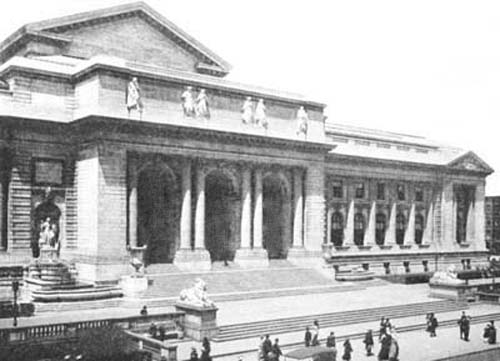 MAIN ENTRANCE
MAIN ENTRANCE
"The Library," wrote Mr. A. C. David, in the Architectural Record[1], "is undeniably popular. It has already taken its place in the public mind as a building of which every New Yorker may be proud, and this opinion of the building is shared by the architectural profession of the country. Of course, it does not please everybody; but if American architects in good standing were asked to name the one building which embodied most of what was good in contemporary American architecture, The New York Public Library would be the choice of a handsome majority."
Mr. David continued: "The Library is not, then, intended to be a great monumental building, which would look almost as well from one point of view as another, and which would be fundamentally an example of pure architectural form. It is designed rather to face on the avenue of a city, and not to seem out of place on such a site. It is essentially and frankly an instance of street architecture; and as an instance of street architecture it is distinguished in its appearance rather than imposing. Not, indeed, that it is lacking in dignity. The façade on Fifth Avenue has poise, as well as distinction; character, as well as good manners. But still it does not insist upon its own peculiar importance, as every monumental building must do. It is content with a somewhat humbler rôle, but one which is probably more appropriate. It looks ingratiating rather than imposing, and that is probably one reason for its popularity. It is intended for popular rather than for official use, and the building issues to the people an invitation to enter rather than a command....
"The final judgment on the Library will be, consequently, that it is not a great monument, because considerations of architectural form have in several conspicuous instances been deliberately subordinated to the needs of the plan. In this respect it resembles the new Museum of Fine Arts in Boston. The building is at bottom a compromise between two groups of partly antagonistic demands, and a compromise can hardly ever become a consummate example of architectural form. But, on the other[10] hand, Messrs. Carrère and Hastings have, as in so many other cases, made their compromise successful. Faithful as they have been to the fundamental requirement of adapting the building to its purpose as a library, they have also succeeded in making it look well; and they have succeeded in making it look well partly because the design is appropriate to its function as a building in which books are stored, read and distributed. A merely monumental library always appears somewhat forbidding and remote. The Library looks attractive, and so far as a large building can, even intimate....
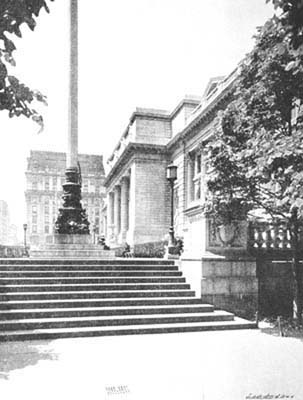 TERRACE IN FRONT OF LIBRARY
TERRACE IN FRONT OF LIBRARY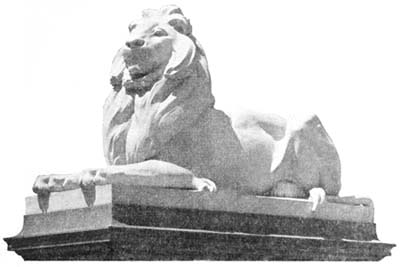 By Edward C. Potter
By Edward C. Potter
"The popularity of the Library has, consequently, been well earned. The public has reason to like it, because it offers them a smiling countenance; and the welcome it gives is merely the outward and visible sign of an inward grace. When people enter they will find a building which has been ingeniously and carefully adapted to their use. Professional architects like it, because they recognize the skill, the good taste and the abundant resources of which the building, as a whole, is the result; and while many of them doubtless cherish a secret thought that they would have done it better, they are obliged to recognize that in order to have done it better they would have been obliged to exhibit a high degree of architectural intelligence. In the realism of its plan and in the mixture of dignity and distinction in the design, The New York Public Library is typical of that which is best in the contemporary American architectural movement; and New York is fortunate, indeed, that such a statement can be made of the most important public building erected in the city during several generations."
 TERRACE LOOKING NORTH
TERRACE LOOKING NORTH
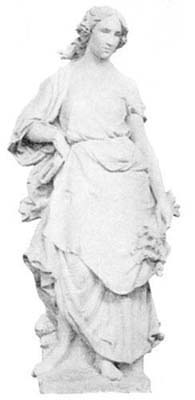 ROMANCE By Paul Bartlett
ROMANCE By Paul Bartlett
Sculpture. Of the sculptural designs, the two lions on either side of the main approach are by E. C. Potter. They have been subjected to much criticism, mainly of a humorous nature, and in the daily press. This adverse comment has not been endorsed by critics of art and architecture. Mr. Potter was chosen for this work by Augustus St. Gaudens, and again, after Mr. St. Gaudens' death, by Mr. D. C. French, also an eminent sculptor. Any layman can satisfy himself, by a brief observation of the building as a whole, that the architectural balance of the structure demands figures of heroic size to flank the main approach. With that requirement in view, the designer of such figures has but a limited choice of subject, since there are few living creatures whose forms possess dignity without being cumbrous. The sculptor in this instance has followed well-estab[14]lished precedents in designing the lions according to the canons of decorative art. They are as realistic as would be suitable for figures of this size, and in this position.
The groups in the pediments are by George Gray Barnard; the one in the northern pediment represents History, and the one in the southern, Art.
The figures above the fountains on either side of the main entrance are by Frederick MacMonnies; the man seated on the Sphinx, on the northern side of the entrance represents Truth. On the southern side, the figure of the woman seated on Pegasus represents Beauty. Above the figure of Truth is this inscription from the Apocrypha (1 Esdras, chapter 3):
BUT ABOVE ALL THINGS
TRUTH
BEARETH AWAY
THE VICTORY
The inscription above the figure of Beauty is:
BEAUTY
OLD YET EVER NEW
ETERNAL VOICE
AND INWARD WORD
[15]
This is from the twenty-first stanza of Whittier's poem, "The Shadow and the Light."
The six figures above the main entrance are by Paul Bartlett; naming them from north to south they are: History, Drama, Poetry, Religion, Romance, and Philosophy. Above the entrance are inscriptions concerning three of the component parts of The New York Public Library. They are as follows:
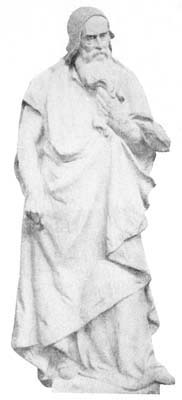 PHILOSOPHY By Paul Bartlett
PHILOSOPHY By Paul Bartlett
THE LENOX LIBRARY
FOUNDED BY
JAMES LENOX
DEDICATED TO HISTORY
LITERATURE AND THE FINE ARTS
MDCCCLXX
THE ASTOR LIBRARY
FOUNDED BY
JOHN JACOB ASTOR
FOR THE
ADVANCEMENT OF USEFUL KNOWLEDGE
MDCCCXLVIII
THE TILDEN TRUST
FOUNDED BY
SAMUEL JONES TILDEN
TO SERVE THE INTERESTS OF
SCIENCE AND POPULAR EDUCATION
MDCCCLXXXVI
Beneath these is this inscription:
MDCCCXCV THE NEW YORK PUBLIC LIBRARY MDCCCCII
Of the dates in this inscription, the first, 1895, is that of the incorporation of The New York Public Library; the second, 1902, is that of the laying of the cornerstone.
The statue of William Cullen Bryant, behind the Library, is by Herbert Adams.
The rear of the building should be viewed from Bryant Park. The long windows are to light the bookstack. Some critics have commended the rear of the building very highly. Mr. A. C. David, in the article previously quoted, says:
"This façade is very plainly treated, without any pretence to architectural effect. It is, indeed, designed [16]frankly as the rear of a structure which is not meant to be looked at except on the other sides. Any attempt, consequently, at monumental treatment has been abandoned. The building is designed to be seen from Fifth Avenue and from the side streets. The rear, on Bryant Park, merely takes care of itself; and one of the largest apartments in any edifice in the United States is practically concealed, so far as any positive exterior result is concerned."
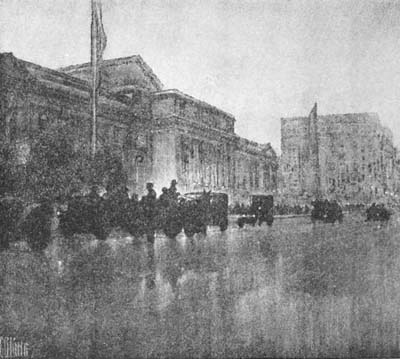 A RAINY DAY—FIFTH AVENUE
A RAINY DAY—FIFTH AVENUEThe large apartment referred to in this quotation is the Main Reading Room of the Library, which is described farther on in this Handbook.[17]
FIRST FLOOR
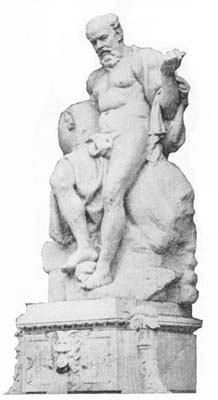 TRUTH
TRUTHEntrances. There are two entrances to the Library, the main entrance on Fifth Avenue, and the side door on 42nd Street, which gives admission to the basement, where the Central Circulation Room, the Newspaper Room and the Central Children's Room are to be found. On a first visit, however, the sightseer should use the main entrance on Fifth Avenue, in order to see the lobby, which rises through two stories, with broad staircases to the right and left. The flying arches of these staircases are of seventeen feet span, and are all of marble without any brick or metal work whatever. The marble used in the lobby is from Vermont. The ceiling is a true marble vault of forty feet span, supporting itself and the floor over it, with no metal whatever, except some reinforcing rods buried in the concrete filling in the floor above.
Between the pillars facing the entrance are two inscriptions. At the left is this:
THE CITY OF NEW YORK
HAS ERECTED THIS BUILDING
TO BE MAINTAINED FOREVER
AS A FREE LIBRARY
FOR THE USE OF THE PEOPLE
And at the right:
ON THE DIFFUSION OF EDUCATION
AMONG THE PEOPLE
REST THE PRESERVATION
AND PERPETUATION
OF OUR FREE INSTITUTIONS
The latter is a quotation from an address by Daniel Webster at Madison, Indiana, June 1, 1837.
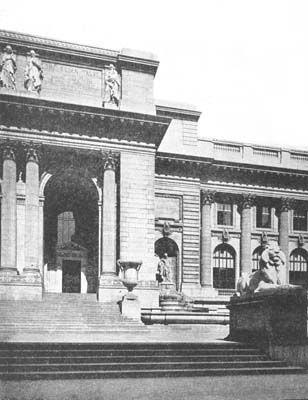 PART OF MAIN FAÇADE
PART OF MAIN FAÇADE
Elevators are near the northern or 42nd Street end of the building. There is also a staircase at this end of the building, in addition to the staircases near the main entrance.

Exhibition Room. Directly opposite the main entrance is the Exhibition Room, finished in white Vermont marble. The ceiling is supported by twenty-four columns of green veined white marble. The ceiling itself is elaborately and beautifully carved in oak. This room is devoted to exhibitions of rare books, manuscripts and prints. The exhibitions are changed from time to time, usually as often as three or four times a year. Open 9 a. m. to 6 p. m. on week days; 1 to 5 p. m. Sundays.
Current Periodicals Room. The corridor to the south from the main entrance leads to the Current Periodicals Room (Room Number 111). Here about 4,500 current periodicals are on file. A hundred of these are on open racks. The others may be obtained upon application at the desk. A classified finding list gives the reader the titles of periodicals kept here. As this room is sometimes confused in the public mind with a popular or club reading room, it should be remembered that this is one department in a building primarily devoted[20] to the reference work of the Library. The few restrictions which are imposed are only for the purpose of keeping the files intact for binding. The Branches of The New York Public Library contain reading rooms where all the periodicals are on open racks.
Business Offices. Following the corridor leading south and then turning to the right along the 40th Street side of the building, one reaches some of the business offices of the Library—the office of the Bursar (No. 104), of the Building Superintendent (No. 103), of the Chief of the Circulation Department (No. 102), and of the Supervisor of work with children (No. 105). These offices are open for any persons who have occasion to visit them for business reasons, but they are of no interest to sightseers. In Room 100, devoted mainly to the cataloguing work of the Circulation Department, there is a card catalogue of all the books in this Department,—that is, in the Branches of the Library. The Room is open to the public, for the consultation of this catalogue, on week days from 9 a. m. to 5 p. m.
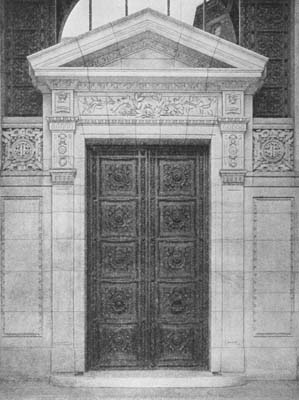 FRONT DOOR
FRONT DOOR
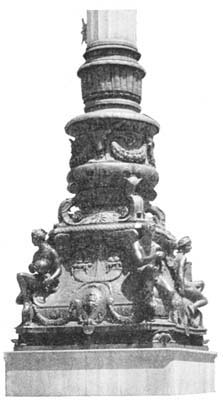 BASE OF FLAGPOLE
BASE OF FLAGPOLE
Technology Division. Following the corridor leading to the north from the main entrance, there is, on the right, the room of the Technology Division (No. 115), devoted to applied science and engineering. The collection of books in this Division, or under its control, numbers about 65,000. In this room, as in all the special reading rooms, with a few exceptions, books are on open shelves for the free access of readers and students.[22]
Patents Room (No. 121). At the end of the corridor parallel to 42nd Street, is the Patents Room, a part of the Technology Division. It is open from 9 a. m. to 6 p. m. on week days, and is closed on Sundays. Patents may be consulted evenings and Sundays by arrangement with the technology librarian, Room 115.
The Library for the Blind (No. 116) is on the inner or western side of the corridor leading north from the main entrance. This collection contains about 8,000 books in embossed type for blind readers, and, in addition, 5,500 music scores, also in embossed type. These books are lent not only in Greater New York, but are sent free by mail to blind readers in all parts of the States of New York, New Jersey, and Connecticut. A teacher employed by the Library goes to homes and institutions in the City of New York to teach adult blind persons to read by touch. The room is open on week days from 9 a. m. to 5 p. m. A bronze tablet on the wall bears the following inscription:[23]
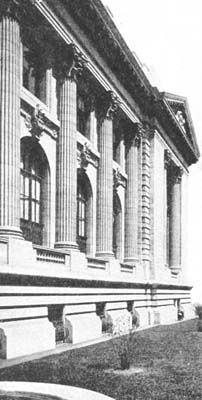 NORTH WING
NORTH WING
THE NEW YORK
FREE CIRCULATING LIBRARY FOR THE BLIND
WAS FOUNDED BY RICHARD RANDALL FERRY
THROUGH THE EXERTIONS OF CLARA A. WILLIAMS
THIS LIBRARY WAS PERMANENTLY ESTABLISHED
INCORPORATED, JUNE 3, 1895
TRANSFERRED TO THE N. Y. PUBLIC LIBRARY, FEB. 21, 1903
TRUSTEES
WILLIAM B. WAIT
CLARA A. WILLIAMS
CLARK B. FERRY
RICHARD RANDALL FERRY
CHARLES W. WESTON
The trustees named on the tablet are, of course, those of the former organization: the "New York Free Circulating Library for the Blind."
SECOND FLOOR
On the second floor a corridor runs along the front of the building, turning into short corridors at the north and south, and also into a central corridor. From these corridors open studies, offices and special reading rooms. In the central corridor, four studies open on the right, while the fifth room on this side is devoted to the:
Oriental Division (No. 219), with a collection of about 20,000 books and pamphlets in Arabic, Persian, Turkish, Chinese, Japanese, and other eastern languages. Open 9 a. m. to 6 p. m. week days.
Jewish Division (No. 217). Opposite the Oriental Division, on the south side of this central corridor, is the reading room devoted to the Jewish Division. There are about 24,000 books in the collection.
Slavonic Division. The room devoted to the Slavonic Division (No. 216) is also on the south side of the central corridor. The resources of this Division, books and periodicals in the various Slavonic languages, number about 23,000.[24]
Science Division. On the corridor parallel to Fifth Avenue, and leading north from the main staircase, the room on the right contains the Science Division (No. 225). There are about 35,000 books under the control of this Division.
Economics Division. From the corridor on the northern or 42nd Street end of the building open the rooms devoted to Public Documents (No. 229) and Economics and Sociology. These were formerly separate divisions, but now united, and the entrance is through Room 229. The resources of the Division (including the large collection of Public Documents) number about 400,000 books and pamphlets.
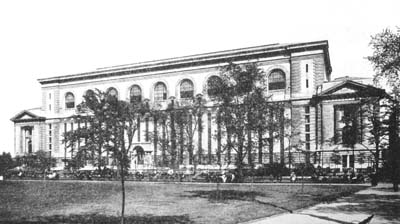 REAR OF LIBRARY FROM BRYANT PARK
REAR OF LIBRARY FROM BRYANT PARK
Business Offices. The rooms opening from the corridor running south from the main staircase are mostly business offices, devoted to the administration of the Library. They are of little interest to sightseers, but are open to any persons who have occasion to visit them. They include, on the front of the building, a lecture room (No. 213), the office of the Director of the Library (No. 210), and the meeting room of the Board of Trustees (No. 205). On the inner or western side of the corridor are: a study (No. 214), the office of the Editor of Publications (No. 212), and of the Reference Librarian (No. 211). The Trustees' Room may be seen on special application at the Director's office. Over the mantelpiece in this room is the inscription:
THE CITY OF NEW YORK HAS ERECTED THIS
BUILDING FOR THE FREE USE OF ALL THE PEOPLE
MCMX
I LOOK TO THE DIFFUSION OF LIGHT AND EDUCATION
AS THE RESOURCE MOST TO BE RELIED ON FOR
AMELIORATING THE CONDITION PROMOTING THE VIRTUE
AND ADVANCING THE HAPPINESS OF MAN
THOMAS JEFFERSON
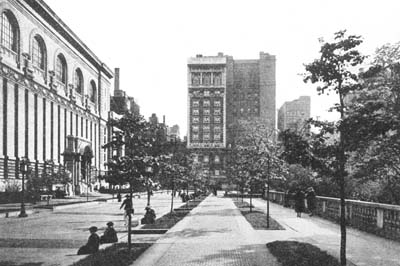 MALL BEHIND LIBRARY
MALL BEHIND LIBRARY
On the corridor leading west, and running along the 40th Street end of the building, are workrooms, open only to visitors having business engagements. These rooms are the office of the Order Division (No. 204) and of the Cataloguing and Accessions Divisions (No. 200 and No. 201).
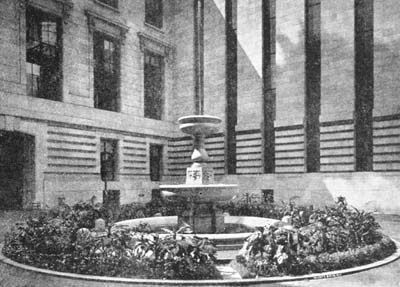 SOUTH COURT
SOUTH COURT
THIRD FLOOR
The most important room on the third floor and, indeed, the centre of activity of the entire Reference Department of the Library, is the Main Reading Room, approached through the Public Catalogue Room. The latter opens from the western side of the corridor at the head of the staircases.
Public Catalogue Room. This room (No. 315) contains the catalogue of the books in the Reference Department of the Library,—that is, the books available to readers in the Main Reading Room and in the special reading[28] rooms of the Central Building. It is a dictionary catalogue, on cards, in which the books are entered by author, by subject, and by title, when the title is distinctive. The catalogue is in trays arranged in alphabetical order, beginning on the northwest wall of the room and running to the right. At the end of this catalogue, and on the southern side of the room, is an author catalogue of the books in the Central Circulation Branch and Central Children's Room, Rooms 78 and 80, in the basement. At the end of this second catalogue and separated from it by a public telephone, is a catalogue of the books in the Library of Congress for which printed catalogue cards have been issued.
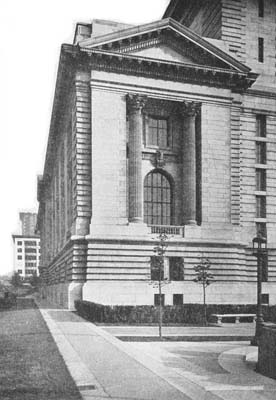 NORTHWEST CORNER
NORTHWEST CORNER
Near the entrance to the Public Catalogue Room, and at the right, is a bronze tablet:
BORN A.D. MDCCCXIII
(Bas-relief of Sir Isaac Pitman)
TABLET ERECTED A.D. MCMXIII
TO COMMEMORATE
THE
ONE HUNDREDTH ANNIVERSARY
OF THE BIRTH OF
SIR ISAAC PITMAN
AND IN RECOGNITION OF THE
IMPORTANT COLLECTION OF
SHORTHAND LITERATURE
IN THE
NEW YORK PUBLIC LIBRARY
Over the door leading from the Public Catalogue Room to the Main Reading Room is inscribed the famous quotation from Milton's "Areopagitica":
A good Booke
is the precious life-blood of a
master spirit, embalm'd and treasur'd
up on purpose to a life beyond life
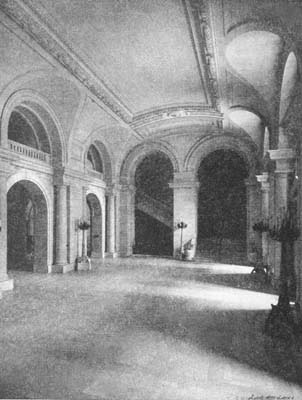 ENTRANCE LOBBY
ENTRANCE LOBBY
Information Desk. The Information Desk of the Library is in the Public Catalogue Room, and here inquiries should be made about the resources and regulations of the Library, the use of the catalogue, and any other matter upon which the visitor may have a question to ask.

Application for books to be used in the Main Reading Room should be made in the Public Catalogue Room. The applicant writes his request upon the slip furnished for the purpose, and files it at the desk in this room. A numbered ticket is handed him, which he takes into the Main Reading Room, going to the right if the ticket number is odd; to the left if the number is even. He then waits at the indicator at the western end of the delivery desk until the number on his ticket appears. This means that his books are ready for him at the desk. If, however, he prefers first to select a seat in the Main Reading Room, he should write the number of that seat on his application, and his books will be left at that seat, if he is there to receive them.
The Main Reading Room, in the rear, extends nearly the entire length of the building. It has a floor area of half an acre, and is divided in the middle by a booth from which books are delivered. There are seats for 768 readers. Mr. A. C. David, in the article previously quoted from the Architectural Record, says:
"The Main Reading Room is one of the most spacious rooms in the world—beautifully proportioned, lighted by a series of windows on both the long sides of the room, and entirely accessible to the stacks. To have obtained a room of these dimensions, so excellently adapted to its purpose in every respect, was a great triumph for the architects."
The shelves along the walls contain a collection of about 25,000 volumes. These books are not only the usual works of reference,—dictionaries, encyclopaedias, and the like, but they also include a good working library of general literature,—philosophy, religion, science, history, law, biography, standard novels, poetry, and the drama. These books are for the free use of anyone in this room, without the need of making any application. The reader has only to select the book he wishes, and to take it to a table, where he may consult it. When he has finished he should leave it on the table, rather than attempt to return it to its place, since a misplaced book is temporarily lost.
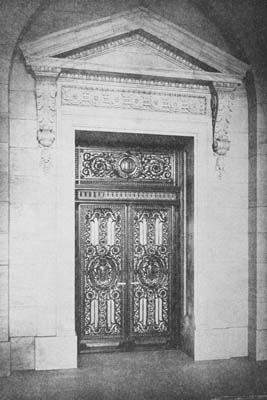 DOOR OF EXHIBITION ROOM
DOOR OF EXHIBITION ROOM
The Library's Books. It should be kept in mind that the books of the Reference Department are all in the Central Building, and must all be used in that building. The great body of them are in the stack beneath the Main Reading Room. In addition, there are the books in the Main Reading Room itself, and in the special reading rooms in other parts of the building. Books and pamphlets number, altogether, about one million and a quarter.
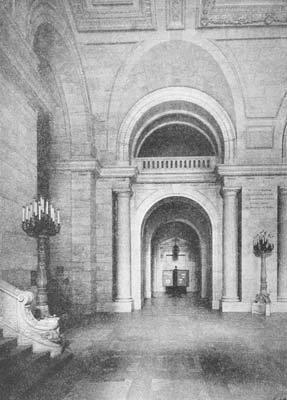 ENTRANCE LOBBY, LOOKING WEST
ENTRANCE LOBBY, LOOKING WEST
The books in the Central Circulation Room and in the Children's Room in the basement, the books in the Library for the Blind, those in the Travelling Libraries office in the basement, and those in the forty-three Branch Libraries in other parts of the Boroughs of Manhattan, The Bronx, and Richmond are under[34] control of the Circulation Department of the Library. Nearly all of these books are lent to borrowers for home use. They number about 1,100,000 volumes.
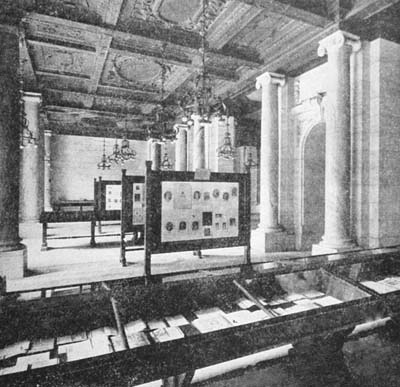 SOUTH SIDE OF EXHIBITION ROOM
SOUTH SIDE OF EXHIBITION ROOM
 MAIN READING ROOM
MAIN READING ROOM
In regard to the books in the Reference Department, it is correct to say that in them the Library owns a well-balanced collection for research in nearly every branch of human knowledge. The books formerly in the Astor and Lenox Libraries compose the foundation of the collection. The subjects most adequately represented are those of American history, of[36] topics connected with the American continents, and the economic and social sciences. There are also extensive sets of public documents, of the publications of learned institutions, as well as comprehensive files of periodicals. In recent years not so much attempt has been made to get publications on law, theology, medicine and biology, since there are special libraries, elsewhere in the City, where these subjects are covered. The reader is nevertheless sure to find in the special reading rooms, and in the books which may be brought to the Main Reading Room for his use, the fundamental printed sources in practically every field of knowledge.
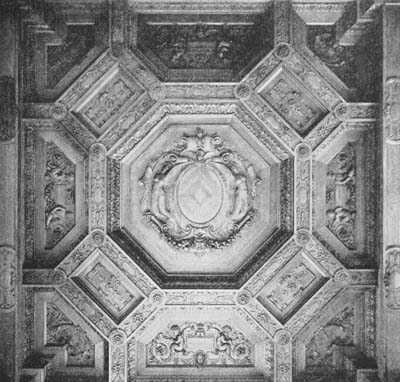 PANEL IN CEILING, EXHIBITION ROOM
PANEL IN CEILING, EXHIBITION ROOM
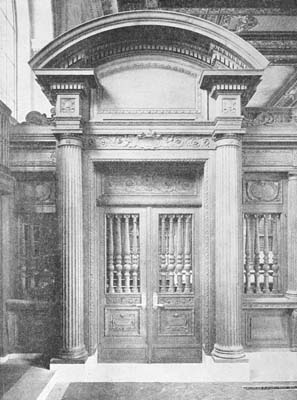 DOOR IN SCREEN
DOOR IN SCREEN
Use of Books. The Library's situation in the metropolis, and its freedom from restrictions (according to the custom of American libraries) have caused the use of its books to become two or three times greater than that of any of the other large libraries of the world; the average daily number of readers is more than double the number in any foreign library.
Stack. Underneath the Main Reading Room is the steel stack, in seven decks, containing 334,500 feet, or 63.3 miles, of shelving. It has room for about 2,500,000 books. (The special reading rooms have a shelf capacity for about 500,000 books.) The books in the stack are brought by electric elevators to the Main Reading Room, as they are called for by readers. The stack is not open to readers or visitors.
Genealogy Room. At the northern end of the Main Reading Room is the room devoted to Local History and Genealogy (No. 328). The collection numbers about thirty thousand volumes.
American History Division. At the southern end of the Main Reading Room is the room devoted to American history (No. 300). It is one of the strongest[40] divisions of the Library, since its books are so distinguished among collections of this kind as to make them of the greatest importance to students and scholars in the field of American history. The foundation of this collection was formed by the books on American history owned by James Lenox, the founder of the Lenox Library, one of the components of the present New York Public Library. The tablet in the floor near the entrance of Room 300 is inscribed as follows:
IN MEMORY OF
JAMES LENOX
A NATIVE AND RESIDENT OF THE CITY OF NEW YORK
BORN AUGUST 19 1800
DIED FEBRUARY 17 1880
THE TRUSTEES OF
THE NEW YORK PUBLIC LIBRARY
ASTOR LENOX AND TILDEN FOUNDATIONS
IN PERFORMANCE OF A GRATEFUL DUTY
HAVE CAUSED THIS TABLET TO BE PLACED
HERE AMONG THE BOOKS HE CHERISHED
AS A MEMORIAL OF HIS SERVICES
TO THE HISTORY OF AMERICA
From the corridors on the front and sides of the third floor, rooms open in the following order, beginning with the corridor at the south, running along the 40th Street side of the building:
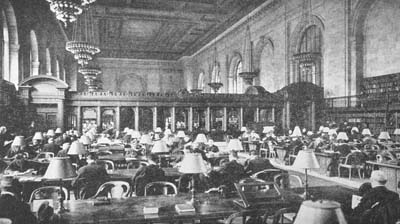 PART OF MAIN READING ROOM
PART OF MAIN READING ROOM
Reserve Books (No. 303): In this room are kept the rare and reserved books of the Library.
Among the foremost treasures of the Library are: the Gutenberg Bible (printed by Gutenberg and Fust about 1455, one of the earliest books printed from movable types); the Coverdale Bible (1535); Tyndale's Pentateuch (1530) and New Testament (1536); and Eliot's Indian Bible. In fact, the collection of early Bibles in English is one of the great collections of the kind in existence. The Library also owns four[42] copies of the First Folio Shakespeare (1623); several copies of the Second, Third, and Fourth Folios (1632, 1663-64, 1685); thirty-five editions of the Shakespeare Quartos, before 1709; eight works printed by William Caxton (1475-90); the Bay Psalm Book, the first book printed in the territory now comprised in the United States (Cambridge, 1640); and the Doctrina Christiana, printed in Mexico in 1544.
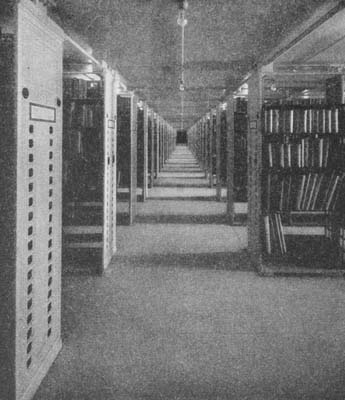 BOOK STACK
BOOK STACKOne contribution to the Library has been commemorated by a tablet near the door of this room. It bears the inscription:
THE
BAILEY MYERS COLLECTION
OF
AMERICANA
FORMED BY
THEODORUS BAILEY MYERS
OF
NEW YORK CITY
1821-1888
GIVEN BY HIS WIDOW, DAUGHTER
AND DAUGHTER-IN-LAW AS A
MEMORIAL OF HIM AND HIS SON
THEODORUS BAILEY MYERS MASON
LIEUTENANT COMMANDER
UNITED STATES NAVY
Opposite, in Room 304, is the office of the Bibliographer of the Library, and of the Chief of the American History Division.
Prints Room. Opening from the corridor on the east (the front) of the Library is the Prints Room (No. 308). Open 9 a. m. to 6 p. m. week days; 1 to 6 p. m. Sundays. Here is the Samuel P. Avery Collection of 18,000 prints. They are mainly French and other modern etchings and lithographs. There is also a large collection of modern American prints, a collection of Japanese prints in color, and a collection of old prints illustrating the development of reproductive graphic art to the present day.
Art and Architecture. Room 313 is the reading room devoted to Art and Architecture. The resources of the collection, about 25,000 books, deal with art and craftsmanship in the widest sense.[44]
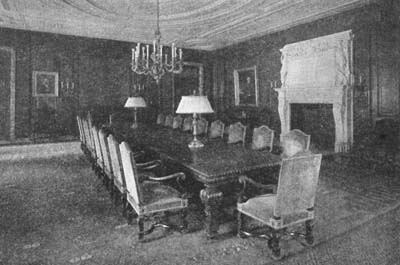 TRUSTEES' ROOM
TRUSTEES' ROOM
Map Room. On the inner, or western, side of this corridor, opposite Room 313, is the Map Room (No. 312), a part of the American History Division. Open 9 a. m. to 6 p. m. on week days.
Stuart Gallery. Opening from the corridor on the front of the building, and directly opposite the entrance to the Public Catalogue Room, is the room devoted to the Stuart Collection (No. 316). Open 9 a. m. to 6 p. m. on week days. Closed on Sundays. This contains pictures, books, and other objects of art bequeathed by Mrs. Robert L. Stuart. On the east wall of the Gallery is a tablet with this inscription:
THE
ROBERT L. STUART
COLLECTION
THE GIFT OF HIS WIDOW,
MRS. MARY STUART.
BEQUEATHED TO THE
LENOX LIBRARY
1892.
Catalogues of the paintings are on sale for ten cents.
General Gallery. The next room to the north is the general gallery (No. 318). (Sign reads "Picture Gallery.") The pictures in this room are largely from the collection of James Lenox. The catalogue, mentioned in the preceding paragraph, gives a list of them, and a brief description of many. Open 9 a. m. to 6 p. m. week days and 1 to 5 p. m. Sundays.
Prints Gallery. Opening from No. 318, and also from the north end of the front corridor, is the Prints Gallery (No. 321). Here are held exhibitions of prints, changed several times each year. Open 9 a. m. to 6 p. m. on week days and 1 to 5 p. m. Sundays.[46]
Manuscript Division. On the west or inner side of the front corridor is the research room of the Manuscript Division (No. 319). This is open only to those who hold cards signed by the Director of the Library. Open 9 a. m. to 6 p. m. week days. The Division has a good selection of Oriental manuscripts, and of European illuminated manuscripts. Among these older ones may be mentioned an "Evangelistarium, sive Lectiones ex Evangeliis," a French-Carlovingian manuscript on 200 vellum leaves, date about 870 A. D. Another manuscript of special note is the work of Giulio Clovio, his "Christi Vita ab Evangelistis descripta," sometimes called "The Towneley Lectionary." It was made for Alexander, Cardinal Farnese, and was presented by him to Pope Paul III.
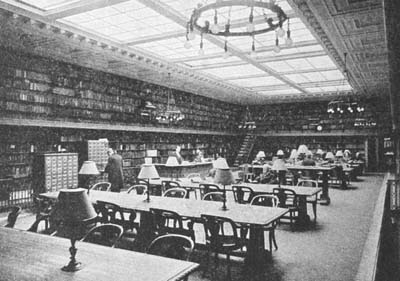 ONE OF THE SPECIAL READING ROOMS
ONE OF THE SPECIAL READING ROOMSThe collection of American historical manuscripts[47] ranks as one of the best in the United States. Here, for example, is the original manuscript of Washington's "Farewell Address," a copy of the Declaration of Independence in Jefferson's autograph, and many other letters and original sources for research. Lists of the principal manuscripts have been printed in the Bulletin of The New York Public Library (Volume 5, page 306-336, and volume 19, page 135-162).
Music Division. Turning to the west, the corridor along the 42nd Street side of the building leads to the Music Division (No. 324), which opens from the north side of the corridor. It is open week days from 9 a. m. to 6 p. m. The resources of the Division number about twenty-two thousand volumes and pieces of music.
A tablet at the north end of the room bears this inscription:
DREXEL MUSICAL LIBRARY.
THE LEGACY OF JOSEPH W. DREXEL 1888.
On the east wall is a tablet reading as follows:
IN MEMORY OF
1855 JULIAN EDWARDS 1910
WHOSE COLLECTION OF MUSIC SCORES
AND BOOKS WAS GIVEN TO THIS LIBRARY
BASEMENT
The basement contains three rooms of public interest. The entrance from 42nd Street is the most convenient way to reach these rooms from the outside of the building, but a visitor on one of the upper floors should take the elevator or the staircase, both near the north end of the building.
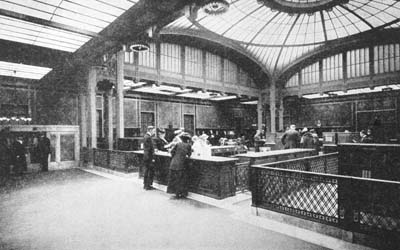 CENTRAL CIRCULATION ROOM
CENTRAL CIRCULATION ROOM
Newspaper Room. In the Newspaper Room (No. 84) about sixty daily newspapers are on racks for free use, without the need of any application. About twenty-five foreign newspapers are obtainable upon[48] application at the desk. A bulletin board at the right of the entrance gives full information about these and other resources of the Newspaper Room.
On the western side of the entrance corridor, near the door of the Circulating Library, is a bronze tablet with the following inscription:
[Seal of The New York Public Library]
THIS BUILDING IS ERECTED
UPON A PART OF THE COMMON LANDS
WHICH WERE GRANTED BY ROYAL CHARTER
TO THE MAYOR ALDERMEN AND COMMONALTY
OF THE CITY OF NEW YORK
IN 1686,
THE SECOND YEAR OF THE REIGN OF JAMES THE SECOND
KING OF ENGLAND.
THE CITY OF NEW YORK IN 1897,
WILLIAM L. STRONG BEING MAYOR,
UNDERTOOK TO CONSTRUCT,
AT THE PUBLIC EXPENSE,
A BUILDING UPON THIS SITE
TO BE USED AND OCCUPIED BY
THE NEW YORK PUBLIC LIBRARY,
ASTOR, LENOX AND TILDEN FOUNDATIONS
SO LONG AS IT SHOULD MAINTAIN HEREIN
A FREE LIBRARY AND READING ROOM FOR THE PEOPLE.
WORK WAS BEGUN BY THE CITY IN 1899,
ROBERT ANDERSON VAN WYCK BEING MAYOR.
THE CORNERSTONE WAS LAID IN 1902,
SETH LOW BEING MAYOR.
THE BUILDING WAS COMPLETED IN 1909,
GEORGE BRINTON McCLELLAN BEING MAYOR.
IT WAS OCCUPIED AND OPENED TO THE PUBLIC IN 1911
WILLIAM JAY GAYNOR BEING MAYOR.
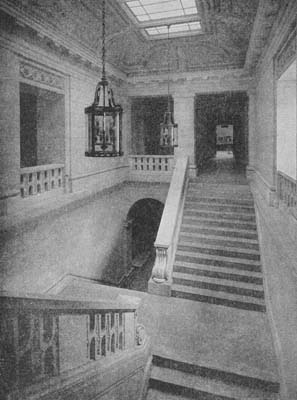 NORTH STAIRCASE
NORTH STAIRCASE
Central Circulation Branch (sign over door reads, "Circulating Library") (No. 80). This is one of the forty-four Branches of The New York Public Library,[50] intended for the circulation of books for home use. In this instance alone the Branch is situated in the Central Building and is supported by the funds of the Library and not by the City. The room is interesting because of its activity. The view of it reproduced in[51] this book had to be taken when but few people were there, but during afternoons and evenings, especially in the autumn, winter, and spring months, the room is frequently over-crowded with readers and borrowers of books. As over 500,000 books were borrowed from this one room during 1915 it may be said that there are few, if any, busier library rooms in the country, or, indeed, in the world. There is a collection of over 50,000 books, with a reserve collection of somewhat more than 70,000. The room is open 9 a. m. to 10 p. m. week days, including all holidays, and 2 to 6 p. m. on Sundays.
Children's Room. Near the 42nd Street entrance a corridor runs east to the Children's Room (No. 78). The visitor to the building should not fail to see this room, with its attractive furnishings, its collections of brightly colored picture-books, and pictures.
The object of the room is not only to perform the usual work of a children's room, but also to interest and help parents and others in selecting children's reading. Authors, artists, and publishers come here for information about books for children. Another purpose is to furnish suggestions for similar rooms elsewhere. A number of libraries, in other parts of the world, have adopted suggestions which they found here. Exhibitions on various subjects are held from time to time, and there is a collection of children's books of the old-fashioned kind. Open 9 a. m. to 6 p. m. week days.
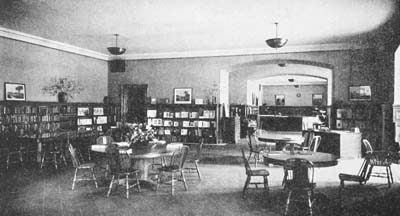 CHILDREN'S ROOM
CHILDREN'S ROOM
Library School. Here a two years' course in training for library work is given to a body of students averaging about seventy-five in number. The office of the School (where inquiries should be made) is in[52] Room 75, on the inner or western side of the corridor which runs along the front of the building, parallel to Fifth Avenue. The Library School class room, not open to the public, is on the other side of the corridor.
Public Telephones. The public telephones are in Room 70, on the inner or western side of the front corridor.
Business Offices. The rest of the basement floor is occupied by offices, open only to those who have business engagements therein. The offices include that for Printing and Binding (No. 58), and the Shipping Room (No. 51). In the Printing Office the catalogue cards of the Library, printed forms, and all the Library's publications are printed. For the publications, see page 78.
Travelling Libraries Office. The entrance to the Travelling Libraries office is from Bryant Park, at the southwest corner of the building. The office itself is not of interest to sightseers. As it is under control of the Circulation Department, its work is described on page 59.
FOOTNOTE:
[1] September, 1910.

Branch Libraries—Hours of Opening: Central Circulation open 9 a. m. to 10 p. m. every week day, 2 to 6 p. m. on Sundays. Children's Room 9 a. m. to 6 p. m. on week days. Library for the Blind, Travelling Libraries, and offices open 9 a. m. to 5 p. m. on week days.
Other Branches, 9 a. m. to 9 p. m. on week days. Exceptions as follows: Central Circulation and branches in Carnegie buildings open full hours on all holidays; other branches closed on January 1, May 30, July 4, December 25, presidential election day, and Thanksgiving; after 6 p. m. on February 22 and Christmas eve; after 5 p. m. on election days other than presidential elections.
The Circulation Department of the Library performs its work through forty-four Branch Libraries in the Boroughs of Manhattan, Richmond (Staten Island), and The Bronx. (Each of the other two Boroughs of Greater New York, Brooklyn and Queens, has its own Public Library.) These Branches are in separate buildings, with the exception of the Circulation Branch in the Central Building. That is supported by the funds of the Library; all the others are maintained by the City. Thirty-seven of the Branch buildings were erected from funds given by Mr. Andrew Carnegie. The collections of books in the Branches number from ten to fifty thousand, with a total of about 1,100,000 books.
Each Branch has an adult department, with its collection of books for adult readers, a children's room, and a reading room with current magazines, reference books, and, in many cases, daily newspapers. Many of the Branches contain lecture or assembly rooms.
These Branch Libraries serve a population estimated at above three million. The Branches are spread over a large territory, and from the northernmost of them, in the Borough of The Bronx, to the one farthest south, on Staten Island, the distance is about forty miles. A directory of Branches is on page 77.
Circulation of Books. The New York Public Library, according to the general custom of American libraries, imposes few restrictions upon its readers.[56] This fact, together with its situation in the metropolis of the country, is the reason why it is probably used more than any other library under one management in the world. The use is constantly growing. In 1915 there were borrowed from the Branch Libraries, for home use, 10,384,579 books.
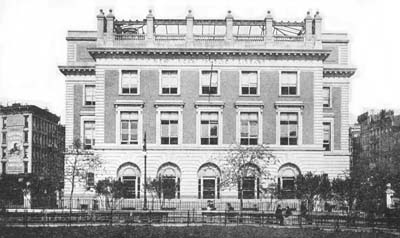 SEWARD PARK BRANCH
SEWARD PARK BRANCH
Special Collections. There are books in foreign languages, especially French and German, in all the Branches. The principal collections of books in foreign tongues other than French and German, are these:
| Language | Branch |
| Bohemian | Webster. |
| Chinese | Chatham Square. |
| Danish | Tottenville, 125th Street. |
| Dutch | Muhlenberg. |
| Finnish | 125th Street. |
| Flemish | Muhlenberg. |
| Greek (Modern) | Muhlenberg. |
| Hebrew | Seward Park, Aguilar. |
| Hungarian | Tompkins Square, Hamilton Fish Park, Yorkville, Woodstock. |
| Italian | Hudson Park, Aguilar, Bond Street. |
| Norwegian | Tottenville. |
| Polish | Rivington Street, Tompkins Square, Columbus, Melrose. |
| Roumanian | Rivington Street. |
| Russian | Seward Park, Rivington Street, Hamilton Fish Park, 96th Street, Chatham Square. |
| Slovak | Webster. |
| Spanish | Jackson Square. |
| Swedish | 125th Street, 58th Street. |
| Servian | Muhlenberg. |
| Yiddish | Rivington Street, Seward Park, Hamilton Fish Park, Aguilar, Tremont. |
Interbranch Loan. A book in any one of the Branches is available to a reader at any other Branch through a system of interbranch loans.
Reading Rooms. The total attendance in the adult reading rooms in the Branch Libraries, during 1915, was 1,224,526. The greatest use of reading rooms is at two of the Branches on the lower East Side.[58]
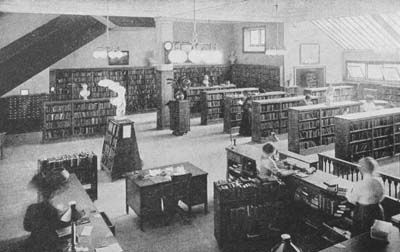 ADULTS' ROOM—58th STREET BRANCH
ADULTS' ROOM—58th STREET BRANCH
Library for the Blind. The Library for the Blind, although under control of the Circulation Department, has its headquarters and reading room in the Central Building. Its work has been described on page 22.
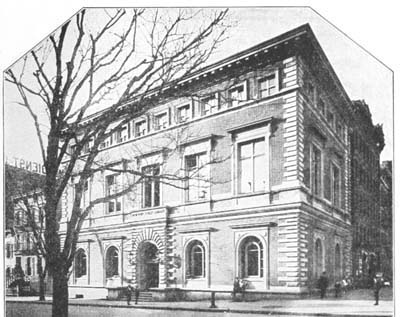 MOTT HAVEN BRANCH
MOTT HAVEN BRANCH
Travelling Libraries. From the office of the Travelling Libraries, in the Central Building, collections of books are sent to communities and homes in outlying districts of the city; to churches, Sunday schools, settlements, clubs, stores, factories,—in fact, to any community or institution not readily served by a Branch Library. There are about 800 stations with Travelling Libraries. The circulation through these agencies, in 1915, numbered 962,355 books. Travelling Library stations are established in mercantile houses, in Fire and Police stations, fire boats, Federal, State, and City[60] Department offices, armories, ships of the coast guard, vacation playgrounds, and summer camps. Books are sent in this manner to prisons, workhouses, elementary and high schools, hospitals, and army posts in New York City.
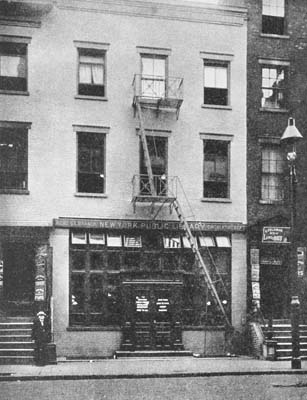 BOND STREET BRANCH
BOND STREET BRANCH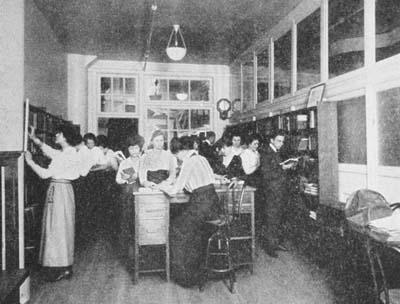 TRAVELLING LIBRARY IN A MERCANTILE HOUSE
TRAVELLING LIBRARY IN A MERCANTILE HOUSE
Work with Children. The work with children comprises a great deal besides the maintenance of children's rooms and the circulation of children's books. In 1915, the total circulation of books to children, including the figures recorded by the juvenile work of the Travelling Libraries, was 4,415,794, or forty-two per cent. of the total circulation of the Library. The Library works with the schools and museums. It holds special exhibitions, meetings, and celebrations of interest to children and to parents. Between fifty and sixty reading[62] clubs for the older boys and girls meet at the Branch Libraries. Groups of children gather in the Branches from November to May, to attend "story hours."
Lectures and meetings. The Branches are used as meeting places by literary, educational and social organizations and clubs. Assembly rooms in the Branches are open for any meeting of an instructive or literary nature, provided that no admission fee is charged, and that nothing of a political or sectarian character is discussed. Many classes of foreigners learning English meet regularly in the Branch Libraries.
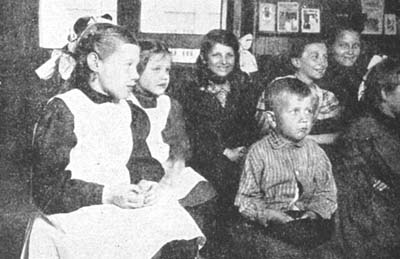 AT A STORY HOUR
AT A STORY HOUR
The New York Public Library, as it exists to-day, is the result of the generosity of a few private citizens, combined with the efforts of the City itself. Its corporate existence, in its present form, began on May 23, 1895, by the consolidation of: "The Trustees of the Astor Library," "The Trustees of the Lenox Library," and "The Tilden Trust."
 LIBRARY'S INSTRUCTOR TEACHING THE BLIND TO READ
LIBRARY'S INSTRUCTOR TEACHING THE BLIND TO READ
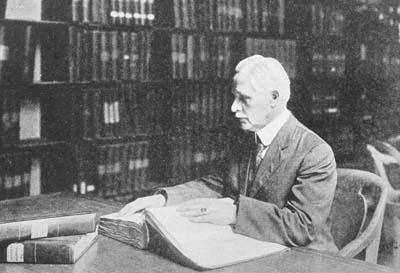 READING WITH THE FINGERS IN THE LIBRARY FOR THE BLIND
READING WITH THE FINGERS IN THE LIBRARY FOR THE BLIND
The Astor Library, originally incorporated in 1849, was founded by John Jacob Astor. His gifts, together with those of his sons and grandsons,[64] amounted to about $1,700,000. Washington Irving was the first President of the Library, and Joseph Green Cogswell its first Superintendent, or Librarian. In its building on Lafayette Place (now Lafayette Street) it was for many years one of the literary landmarks of New York. At the time of its consolidation with The New York Public[65] Library it had an endowment fund of about $941,000, which produced an annual income of about $47,000. It contained then 266,147 volumes. It was solely a reference library,—the funds were given with the understanding that the books should not be lent for use outside the building.
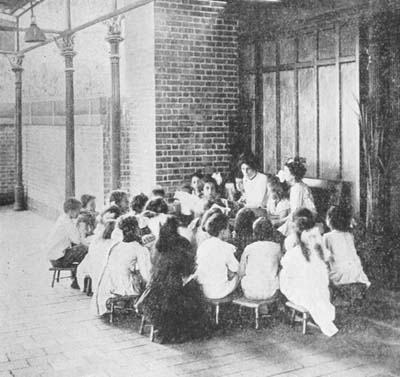 SUMMER AFTERNOON STORY HOUR
SUMMER AFTERNOON STORY HOUR
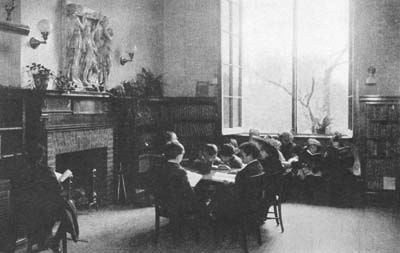 CORNER OF CHILDREN'S READING ROOM, HARLEM LIBRARY
BRANCH
CORNER OF CHILDREN'S READING ROOM, HARLEM LIBRARY
BRANCH
The Lenox Library. James Lenox, one of America's greatest book collectors, was born in New York City in 1800 and died there in 1880. In 1870, by the incorporation of the Lenox Library, he gave to the city of his birth his books and art treasures. The building, which formerly stood on Fifth Avenue between 70th and 71st Streets, was erected for the Library and opened to the public, a part at a time, beginning in 1876. At the time of consolidation the Library owned its building, an endowment fund of $505,500, which yielded an annual income of about $20,500; and about 86,000 volumes. This also was a reference library, not a circulating library.
 VISIT OF A CLASS FROM A PUBLIC SCHOOL
VISIT OF A CLASS FROM A PUBLIC SCHOOL
The Tilden Trust. Samuel Jones Tilden was born in New Lebanon, New York, in 1814. He died in New York City in 1886. By the final settlement of his estate the City received his private library and an endowment fund of about $2,000,000, for library purposes.[68]
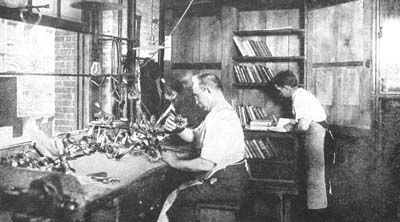 TRAVELLING LIBRARY IN A FACTORY
TRAVELLING LIBRARY IN A FACTORY
Consolidation. In the agreement for consolidation it was provided that the name of the new corporation should be "The New York Public Library, Astor, Lenox and Tilden Foundations"; that the number of its trustees should be twenty-one, to be selected from the thirty-three members of the separate boards; and that "the said new corporation shall establish and maintain a free public library and reading room in the City of New York, with such branches as may be deemed advisable, and shall continue and promote the several objects and purposes set forth in the respective acts of incorporation of 'The Trustees of the Astor Library,' 'The Trustees of the Lenox Library,' and 'The Tilden Trust.'"
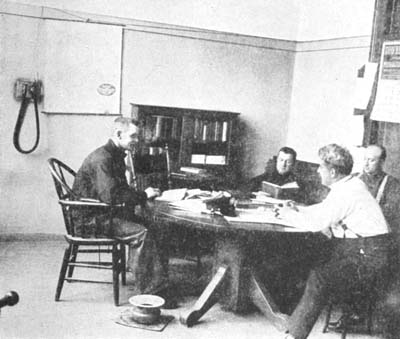 TRAVELLING LIBRARY IN FIRE-ENGINE HOUSE
TRAVELLING LIBRARY IN FIRE-ENGINE HOUSE
Later, another member was added to the Board of Trustees, and three municipal officials were made members ex officio.
The first Director of The New York Public Library was Dr. John Shaw Billings, who served from 1896 until his death in 1913. He rendered distinguished services, especially in the organization of the new Library and in the arrangement of the Central Building.
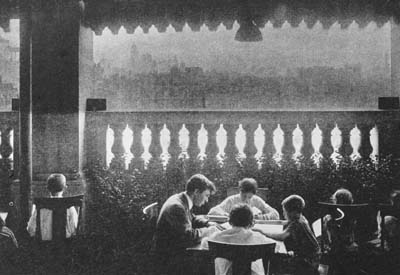 ROOF READING ROOM, SEWARD PARK BRANCH
ROOF READING ROOM, SEWARD PARK BRANCH
New York Free Circulating Library. In 1901 the New York Free Circulating Library was consolidated with the new system. This Library had then eleven Branches and owned about 160,000 volumes.
Other Circulating Libraries. In 1901, the St. Agnes Free Library and the Washington Heights Free Library were also added to the system. The New York Free Circulating Library for the Blind and the Aguilar Free Library, with four Branches, were added in 1903. In 1904, the Harlem Free Library, Tottenville Free Library, the University Settlement Library at Rivington and Eldridge Streets, and the Webster Free Library followed. Also in 1904 the five Branches of the Cathedral Free Circulating Library became part of the new corporation.
Carnegie Branches. In 1901 Mr. Andrew Carnegie offered Greater New York $5,200,000 for the construction and equipment of free circulating libraries, on condition that the City provide the land and agree to maintain the libraries when built. The offer was accepted, and thirty-seven Branch Libraries are now housed in buildings erected with that part of Mr. Carnegie's gift assigned to The New York Public Library. A directory of all the Branch Libraries may be found on page 77.
Management. The corporation is managed by a Board of twenty-five Trustees, including the Mayor, Comptroller, and President of the Board of Aldermen ex officio. The names of the Trustees are given on page[72] 76. The Trustees hold office continuously, and vacancies are filled by vote of the remaining Trustees. No Trustee receives any compensation for his services. The immediate management of the Library is entrusted to the Director. The Staff numbers between twelve and thirteen hundred persons, including those in the Central Building and in the Branches. As the buildings are open between twelve and thirteen hours a day the Staff works in two shifts. Somewhat less than half of the Staff are employed in the Central Building.
 BOYS' CLUB; YORKVILLE BRANCH
BOYS' CLUB; YORKVILLE BRANCH
Benefactors. A complete list of the Library's benefactors, besides the three founders, can more appropriately be given elsewhere. In addition to Mr. Carnegie's gift, one bequest should be noted here: that of John S. Kennedy, who in 1909 left about $3,000,000 to the Library, without conditions.[73]
Work of the Library. This historical sketch may help to make clear the organization and work of the Library as it is carried on to-day. It is a free reference library combined with a free circulating library. The books in the Reference Department (in the Central Building) which came from either the Astor or the Lenox Libraries, and those which have been added since the consolidation, from the endowments of those Libraries, must necessarily be for reference use only. The Astor and Lenox Foundations give the Trustees of The New York Public Library no option in this matter. About one million books in the Circulation Department (the Branch Libraries) are lent for home use.
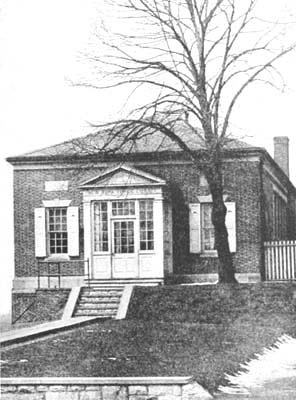 KINGSBRIDGE BRANCH
KINGSBRIDGE BRANCH
William W. Appleton
Andrew Carnegie
Cleveland H. Dodge
John Murphy Farley
Samuel Greenbaum
Frederic R. Halsey
John Henry Hammond
Lewis Cass Ledyard
J. P. Morgan
Morgan J. O'Brien
Stephen H. Olin
Henry Fairfield Osborn
William Barclay Parsons
George L. Rives
Elihu Root
Charles Howland Russell
Edward W. Sheldon
George W. Smith
I. N. Phelps Stokes
Frederick Sturges
Henry W. Taft
Payne Whitney
John Purroy Mitchel, Mayor of the City of New York, ex officio
William A. Prendergast,
Comptroller of the City of New York, ex officio
Frank L. Dowling, President of the Board of Aldermen, ex officio
OFFICERS
President, George L. Rives
First Vice-President, Lewis Cass Ledyard
Second Vice-President, Elihu Root
Secretary, Charles Howland Russell
Treasurer, Edward W. Sheldon
Director of the Library, Edwin H. Anderson
Chief Reference Librarian, H. M. Lydenberg
Chief of the Circulation Department, Benjamin Adams
With the exception of the Central Building, the names of the Branches in Manhattan and The Bronx are arranged as they are situated, from south to north.
Names marked with a star (*) are of Branches occupying Carnegie buildings.
MANHATTAN
Central Building. Fifth Avenue and 42nd Street
Central Circulation
Children's Room
Library for the Blind
Travelling Libraries
Chatham Square.* 33 East Broadway
Seward Park.* 192 East Broadway
Rivington Street,* 61
Hamilton Fish Park.* 388 East Houston Street
Hudson Park.* 66 Leroy Street
Bond Street, 49. Near the Bowery
Ottendorfer. 135 Second Avenue. Near 8th Street
Tompkins Square.* 331 East 10th Street
Jackson Square. 251 West 13th Street
Epiphany.* 228 East 23rd Street
Muhlenberg.* 209 West 23rd Street
St. Gabriel's Park.* 303 East 36th Street
40th Street,* 457 West
Cathedral. 123 East 50th Street
Columbus.* 742 Tenth Avenue. Near 51st Street
58th Street,* 121 East
67th Street,* 328 East
Riverside.* 190 Amsterdam Avenue. Near 69th Street
Webster.* 1465 Avenue A. Near 78th Street
Yorkville.* 222 East 79th Street
St. Agnes.* 444 Amsterdam Avenue. Near 81st Street
96th Street,* 112 East
Bloomingdale. 206 West 100th Street
Aguilar.* 174 East 110th Street
115th Street,* 203 West
Harlem Library.* 9 West 124th Street
125th Street,* 224 East
George Bruce. 78 Manhattan Street
135th Street,* 103 West
Hamilton Grange.* 503 West 145th Street
Washington Heights.* 1000 St. Nicholas Ave. Cor. of 160th St.
Fort Washington.* 535 West 179th Street
THE BRONX
Mott Haven.* 321 East 140th Street
Woodstock.* 759 East 160th Street
Melrose.* 910 Morris Avenue. Corner of 162nd Street.
High Bridge.* 78 West 168th Street
Morrisania.* 610 East 169th Street
Tremont.* 1866 Washington Avenue. Corner of 176th Street
Kingsbridge.* 3041 Kingsbridge Avenue. Near 230th Street
RICHMOND (STATEN ISLAND)
St. George.* 5 Central Avenue. Tompkinsville P. O.
Port Richmond.* 75 Bennett Street
Stapleton.* 132 Canal Street
Tottenville.* 7430 Amboy Road
A reader of this Handbook may wish to know about some other sources of information concerning the Library. For that reason a few of its publications are named here. They may be consulted in the Central Building or any of the Branches.
Annual Report of The New York Public Library. (A limited number are sent to institutions or private persons upon request.)
Bulletin of The New York Public Library. Published monthly. Chiefly devoted to the Reference Department. Bibliography, news of the Library, reprints of manuscripts, descriptions of new accessions. One dollar a year; current single numbers for ten cents. Back numbers at advanced rates.
Branch Library News. Monthly publication of the Circulation Department. Lists of new books, reading lists, articles about books, etc. Given free at the Branches. By mail free to libraries and other public institutions. Otherwise, twenty-five cents a year.
Facts for the Public. A small pamphlet of general information about the Library. Much of its contents is also contained in this Handbook. Given free.
Central Building Guide. A small pamphlet. Price five cents.
As the Central Building of the Library stands on part of the site of the old Croton Reservoir, it is fitting to reprint here the inscriptions on two tablets which were formerly affixed to the Reservoir.
One tablet is now on the first floor of the Central Building, on the wall of the south or 40th Street corridor. The inscription is:
HISTORICAL AND DESCRIPTIVE ACCOUNT
OF THE CROTON AQUEDUCT
The Law authorizing the construction of the work, passed May
2nd, 1834.
STEPHEN ALLEN, WILLIAM W. FOX, SAUL ALLEY,
CHARLES DUSENBERRY and BENJAMIN M. BROWN were appointed
Commissioners.
During the year 1834, two surveys were made—one by DAVID
B. DOUGLASS and the other by JOHN MARTINEAU.
In April, 1835, a majority of the Electors of the City voted in
favour of constructing the Aqueduct.
On the 7th May following, the Common Council "instructed the
Commissioners to proceed with the work."
DAVID B. DOUGLASS was employed as Chief Engineer until
October, 1836; when he was succeeded by JOHN B. JERVIS.
In March, 1837, BENJAMIN M. BROWN resigned, and was succeeded
by THOMAS T. WOODRUFF.
In March, 1840, the before mentioned Commissioners were succeeded
by SAMUEL STEVENS, JOHN D. WARD, ZEBEDEE RING,
BENJAMIN BIRDSALL and SAMUEL R. CHILDS.
The work was commenced in May, 1837. On the 22nd June, 1842,
the Aqueduct was so far completed that it received the Water from the
Croton River Lake; on the 27th the Water entered the Receiving Reservoir
and was admitted into this Reservoir on the succeeding 4th of July.
The DAM at the Croton River is 40 feet high, and the overfall
251 feet in length.
The CROTON RIVER LAKE is five miles long, and covers an
area of 400 acres.
The AQUEDUCT, from the DAM to this Reservoir, is 40½ miles
long, and will deliver in twenty-four hours 60,000,000 imperial gallons.
The capacity of the Receiving Reservoir is 150,000,000 gallons,
and of this reservoir 20,000,000.
The cost, to and including this Reservoir, nearly $9,000,000.
In the pavement of the south court is a tablet with this inscription:
CROTON AQUEDUCT.
DISTRIBUTING RESERVOIR.
COMMISSIONERS.
SAMUEL STEVENS
ZEBEDEE RING
JOHN D. WARD
BENJn BIRDSALL
SAMUEL R. CHILDS
ENGINEERS.
JOHN B. JERVIS. CHIEF.
Ho ALLEN, PRINl ASSIST.
P. HASTIE, RESIDENT.
BUILDERS.
THOMSON PRICE & SON.
COMMENCED A. D. MDCCCXXXVIII.
COMPLETED A. D. MDCCCXLII.
TWENTY-FIVE THOUSAND COPIES
OF THIS FIRST EDITION OF THE
HANDBOOK WERE PRINTED AT
THE NEW YORK PUBLIC LIBRARY
IN JUNE 1916
End of the Project Gutenberg EBook of Handbook of The New York Public Library, by
New York Public Library
*** END OF THIS PROJECT GUTENBERG EBOOK HANDBOOK--NEW YORK PUBLIC LIBRARY ***
***** This file should be named 27954-h.htm or 27954-h.zip *****
This and all associated files of various formats will be found in:
https://www.gutenberg.org/2/7/9/5/27954/
Produced by Carla Foust, and The Online Distributed
Proofreading Team at https://www.pgdp.net (This file was
produced from images generously made available by The
Internet Archive/American Libraries.)
Updated editions will replace the previous one--the old editions
will be renamed.
Creating the works from public domain print editions means that no
one owns a United States copyright in these works, so the Foundation
(and you!) can copy and distribute it in the United States without
permission and without paying copyright royalties. Special rules,
set forth in the General Terms of Use part of this license, apply to
copying and distributing Project Gutenberg-tm electronic works to
protect the PROJECT GUTENBERG-tm concept and trademark. Project
Gutenberg is a registered trademark, and may not be used if you
charge for the eBooks, unless you receive specific permission. If you
do not charge anything for copies of this eBook, complying with the
rules is very easy. You may use this eBook for nearly any purpose
such as creation of derivative works, reports, performances and
research. They may be modified and printed and given away--you may do
practically ANYTHING with public domain eBooks. Redistribution is
subject to the trademark license, especially commercial
redistribution.
*** START: FULL LICENSE ***
THE FULL PROJECT GUTENBERG LICENSE
PLEASE READ THIS BEFORE YOU DISTRIBUTE OR USE THIS WORK
To protect the Project Gutenberg-tm mission of promoting the free
distribution of electronic works, by using or distributing this work
(or any other work associated in any way with the phrase "Project
Gutenberg"), you agree to comply with all the terms of the Full Project
Gutenberg-tm License (available with this file or online at
https://gutenberg.org/license).
Section 1. General Terms of Use and Redistributing Project Gutenberg-tm
electronic works
1.A. By reading or using any part of this Project Gutenberg-tm
electronic work, you indicate that you have read, understand, agree to
and accept all the terms of this license and intellectual property
(trademark/copyright) agreement. If you do not agree to abide by all
the terms of this agreement, you must cease using and return or destroy
all copies of Project Gutenberg-tm electronic works in your possession.
If you paid a fee for obtaining a copy of or access to a Project
Gutenberg-tm electronic work and you do not agree to be bound by the
terms of this agreement, you may obtain a refund from the person or
entity to whom you paid the fee as set forth in paragraph 1.E.8.
1.B. "Project Gutenberg" is a registered trademark. It may only be
used on or associated in any way with an electronic work by people who
agree to be bound by the terms of this agreement. There are a few
things that you can do with most Project Gutenberg-tm electronic works
even without complying with the full terms of this agreement. See
paragraph 1.C below. There are a lot of things you can do with Project
Gutenberg-tm electronic works if you follow the terms of this agreement
and help preserve free future access to Project Gutenberg-tm electronic
works. See paragraph 1.E below.
1.C. The Project Gutenberg Literary Archive Foundation ("the Foundation"
or PGLAF), owns a compilation copyright in the collection of Project
Gutenberg-tm electronic works. Nearly all the individual works in the
collection are in the public domain in the United States. If an
individual work is in the public domain in the United States and you are
located in the United States, we do not claim a right to prevent you from
copying, distributing, performing, displaying or creating derivative
works based on the work as long as all references to Project Gutenberg
are removed. Of course, we hope that you will support the Project
Gutenberg-tm mission of promoting free access to electronic works by
freely sharing Project Gutenberg-tm works in compliance with the terms of
this agreement for keeping the Project Gutenberg-tm name associated with
the work. You can easily comply with the terms of this agreement by
keeping this work in the same format with its attached full Project
Gutenberg-tm License when you share it without charge with others.
1.D. The copyright laws of the place where you are located also govern
what you can do with this work. Copyright laws in most countries are in
a constant state of change. If you are outside the United States, check
the laws of your country in addition to the terms of this agreement
before downloading, copying, displaying, performing, distributing or
creating derivative works based on this work or any other Project
Gutenberg-tm work. The Foundation makes no representations concerning
the copyright status of any work in any country outside the United
States.
1.E. Unless you have removed all references to Project Gutenberg:
1.E.1. The following sentence, with active links to, or other immediate
access to, the full Project Gutenberg-tm License must appear prominently
whenever any copy of a Project Gutenberg-tm work (any work on which the
phrase "Project Gutenberg" appears, or with which the phrase "Project
Gutenberg" is associated) is accessed, displayed, performed, viewed,
copied or distributed:
This eBook is for the use of anyone anywhere at no cost and with
almost no restrictions whatsoever. You may copy it, give it away or
re-use it under the terms of the Project Gutenberg License included
with this eBook or online at www.gutenberg.org
1.E.2. If an individual Project Gutenberg-tm electronic work is derived
from the public domain (does not contain a notice indicating that it is
posted with permission of the copyright holder), the work can be copied
and distributed to anyone in the United States without paying any fees
or charges. If you are redistributing or providing access to a work
with the phrase "Project Gutenberg" associated with or appearing on the
work, you must comply either with the requirements of paragraphs 1.E.1
through 1.E.7 or obtain permission for the use of the work and the
Project Gutenberg-tm trademark as set forth in paragraphs 1.E.8 or
1.E.9.
1.E.3. If an individual Project Gutenberg-tm electronic work is posted
with the permission of the copyright holder, your use and distribution
must comply with both paragraphs 1.E.1 through 1.E.7 and any additional
terms imposed by the copyright holder. Additional terms will be linked
to the Project Gutenberg-tm License for all works posted with the
permission of the copyright holder found at the beginning of this work.
1.E.4. Do not unlink or detach or remove the full Project Gutenberg-tm
License terms from this work, or any files containing a part of this
work or any other work associated with Project Gutenberg-tm.
1.E.5. Do not copy, display, perform, distribute or redistribute this
electronic work, or any part of this electronic work, without
prominently displaying the sentence set forth in paragraph 1.E.1 with
active links or immediate access to the full terms of the Project
Gutenberg-tm License.
1.E.6. You may convert to and distribute this work in any binary,
compressed, marked up, nonproprietary or proprietary form, including any
word processing or hypertext form. However, if you provide access to or
distribute copies of a Project Gutenberg-tm work in a format other than
"Plain Vanilla ASCII" or other format used in the official version
posted on the official Project Gutenberg-tm web site (www.gutenberg.org),
you must, at no additional cost, fee or expense to the user, provide a
copy, a means of exporting a copy, or a means of obtaining a copy upon
request, of the work in its original "Plain Vanilla ASCII" or other
form. Any alternate format must include the full Project Gutenberg-tm
License as specified in paragraph 1.E.1.
1.E.7. Do not charge a fee for access to, viewing, displaying,
performing, copying or distributing any Project Gutenberg-tm works
unless you comply with paragraph 1.E.8 or 1.E.9.
1.E.8. You may charge a reasonable fee for copies of or providing
access to or distributing Project Gutenberg-tm electronic works provided
that
- You pay a royalty fee of 20% of the gross profits you derive from
the use of Project Gutenberg-tm works calculated using the method
you already use to calculate your applicable taxes. The fee is
owed to the owner of the Project Gutenberg-tm trademark, but he
has agreed to donate royalties under this paragraph to the
Project Gutenberg Literary Archive Foundation. Royalty payments
must be paid within 60 days following each date on which you
prepare (or are legally required to prepare) your periodic tax
returns. Royalty payments should be clearly marked as such and
sent to the Project Gutenberg Literary Archive Foundation at the
address specified in Section 4, "Information about donations to
the Project Gutenberg Literary Archive Foundation."
- You provide a full refund of any money paid by a user who notifies
you in writing (or by e-mail) within 30 days of receipt that s/he
does not agree to the terms of the full Project Gutenberg-tm
License. You must require such a user to return or
destroy all copies of the works possessed in a physical medium
and discontinue all use of and all access to other copies of
Project Gutenberg-tm works.
- You provide, in accordance with paragraph 1.F.3, a full refund of any
money paid for a work or a replacement copy, if a defect in the
electronic work is discovered and reported to you within 90 days
of receipt of the work.
- You comply with all other terms of this agreement for free
distribution of Project Gutenberg-tm works.
1.E.9. If you wish to charge a fee or distribute a Project Gutenberg-tm
electronic work or group of works on different terms than are set
forth in this agreement, you must obtain permission in writing from
both the Project Gutenberg Literary Archive Foundation and Michael
Hart, the owner of the Project Gutenberg-tm trademark. Contact the
Foundation as set forth in Section 3 below.
1.F.
1.F.1. Project Gutenberg volunteers and employees expend considerable
effort to identify, do copyright research on, transcribe and proofread
public domain works in creating the Project Gutenberg-tm
collection. Despite these efforts, Project Gutenberg-tm electronic
works, and the medium on which they may be stored, may contain
"Defects," such as, but not limited to, incomplete, inaccurate or
corrupt data, transcription errors, a copyright or other intellectual
property infringement, a defective or damaged disk or other medium, a
computer virus, or computer codes that damage or cannot be read by
your equipment.
1.F.2. LIMITED WARRANTY, DISCLAIMER OF DAMAGES - Except for the "Right
of Replacement or Refund" described in paragraph 1.F.3, the Project
Gutenberg Literary Archive Foundation, the owner of the Project
Gutenberg-tm trademark, and any other party distributing a Project
Gutenberg-tm electronic work under this agreement, disclaim all
liability to you for damages, costs and expenses, including legal
fees. YOU AGREE THAT YOU HAVE NO REMEDIES FOR NEGLIGENCE, STRICT
LIABILITY, BREACH OF WARRANTY OR BREACH OF CONTRACT EXCEPT THOSE
PROVIDED IN PARAGRAPH F3. YOU AGREE THAT THE FOUNDATION, THE
TRADEMARK OWNER, AND ANY DISTRIBUTOR UNDER THIS AGREEMENT WILL NOT BE
LIABLE TO YOU FOR ACTUAL, DIRECT, INDIRECT, CONSEQUENTIAL, PUNITIVE OR
INCIDENTAL DAMAGES EVEN IF YOU GIVE NOTICE OF THE POSSIBILITY OF SUCH
DAMAGE.
1.F.3. LIMITED RIGHT OF REPLACEMENT OR REFUND - If you discover a
defect in this electronic work within 90 days of receiving it, you can
receive a refund of the money (if any) you paid for it by sending a
written explanation to the person you received the work from. If you
received the work on a physical medium, you must return the medium with
your written explanation. The person or entity that provided you with
the defective work may elect to provide a replacement copy in lieu of a
refund. If you received the work electronically, the person or entity
providing it to you may choose to give you a second opportunity to
receive the work electronically in lieu of a refund. If the second copy
is also defective, you may demand a refund in writing without further
opportunities to fix the problem.
1.F.4. Except for the limited right of replacement or refund set forth
in paragraph 1.F.3, this work is provided to you 'AS-IS' WITH NO OTHER
WARRANTIES OF ANY KIND, EXPRESS OR IMPLIED, INCLUDING BUT NOT LIMITED TO
WARRANTIES OF MERCHANTIBILITY OR FITNESS FOR ANY PURPOSE.
1.F.5. Some states do not allow disclaimers of certain implied
warranties or the exclusion or limitation of certain types of damages.
If any disclaimer or limitation set forth in this agreement violates the
law of the state applicable to this agreement, the agreement shall be
interpreted to make the maximum disclaimer or limitation permitted by
the applicable state law. The invalidity or unenforceability of any
provision of this agreement shall not void the remaining provisions.
1.F.6. INDEMNITY - You agree to indemnify and hold the Foundation, the
trademark owner, any agent or employee of the Foundation, anyone
providing copies of Project Gutenberg-tm electronic works in accordance
with this agreement, and any volunteers associated with the production,
promotion and distribution of Project Gutenberg-tm electronic works,
harmless from all liability, costs and expenses, including legal fees,
that arise directly or indirectly from any of the following which you do
or cause to occur: (a) distribution of this or any Project Gutenberg-tm
work, (b) alteration, modification, or additions or deletions to any
Project Gutenberg-tm work, and (c) any Defect you cause.
Section 2. Information about the Mission of Project Gutenberg-tm
Project Gutenberg-tm is synonymous with the free distribution of
electronic works in formats readable by the widest variety of computers
including obsolete, old, middle-aged and new computers. It exists
because of the efforts of hundreds of volunteers and donations from
people in all walks of life.
Volunteers and financial support to provide volunteers with the
assistance they need are critical to reaching Project Gutenberg-tm's
goals and ensuring that the Project Gutenberg-tm collection will
remain freely available for generations to come. In 2001, the Project
Gutenberg Literary Archive Foundation was created to provide a secure
and permanent future for Project Gutenberg-tm and future generations.
To learn more about the Project Gutenberg Literary Archive Foundation
and how your efforts and donations can help, see Sections 3 and 4
and the Foundation web page at https://www.pglaf.org.
Section 3. Information about the Project Gutenberg Literary Archive
Foundation
The Project Gutenberg Literary Archive Foundation is a non profit
501(c)(3) educational corporation organized under the laws of the
state of Mississippi and granted tax exempt status by the Internal
Revenue Service. The Foundation's EIN or federal tax identification
number is 64-6221541. Its 501(c)(3) letter is posted at
https://pglaf.org/fundraising. Contributions to the Project Gutenberg
Literary Archive Foundation are tax deductible to the full extent
permitted by U.S. federal laws and your state's laws.
The Foundation's principal office is located at 4557 Melan Dr. S.
Fairbanks, AK, 99712., but its volunteers and employees are scattered
throughout numerous locations. Its business office is located at
809 North 1500 West, Salt Lake City, UT 84116, (801) 596-1887, email
business@pglaf.org. Email contact links and up to date contact
information can be found at the Foundation's web site and official
page at https://pglaf.org
For additional contact information:
Dr. Gregory B. Newby
Chief Executive and Director
gbnewby@pglaf.org
Section 4. Information about Donations to the Project Gutenberg
Literary Archive Foundation
Project Gutenberg-tm depends upon and cannot survive without wide
spread public support and donations to carry out its mission of
increasing the number of public domain and licensed works that can be
freely distributed in machine readable form accessible by the widest
array of equipment including outdated equipment. Many small donations
($1 to $5,000) are particularly important to maintaining tax exempt
status with the IRS.
The Foundation is committed to complying with the laws regulating
charities and charitable donations in all 50 states of the United
States. Compliance requirements are not uniform and it takes a
considerable effort, much paperwork and many fees to meet and keep up
with these requirements. We do not solicit donations in locations
where we have not received written confirmation of compliance. To
SEND DONATIONS or determine the status of compliance for any
particular state visit https://pglaf.org
While we cannot and do not solicit contributions from states where we
have not met the solicitation requirements, we know of no prohibition
against accepting unsolicited donations from donors in such states who
approach us with offers to donate.
International donations are gratefully accepted, but we cannot make
any statements concerning tax treatment of donations received from
outside the United States. U.S. laws alone swamp our small staff.
Please check the Project Gutenberg Web pages for current donation
methods and addresses. Donations are accepted in a number of other
ways including including checks, online payments and credit card
donations. To donate, please visit: https://pglaf.org/donate
Section 5. General Information About Project Gutenberg-tm electronic
works.
Professor Michael S. Hart was the originator of the Project Gutenberg-tm
concept of a library of electronic works that could be freely shared
with anyone. For thirty years, he produced and distributed Project
Gutenberg-tm eBooks with only a loose network of volunteer support.
Project Gutenberg-tm eBooks are often created from several printed
editions, all of which are confirmed as Public Domain in the U.S.
unless a copyright notice is included. Thus, we do not necessarily
keep eBooks in compliance with any particular paper edition.
Most people start at our Web site which has the main PG search facility:
https://www.gutenberg.org
This Web site includes information about Project Gutenberg-tm,
including how to make donations to the Project Gutenberg Literary
Archive Foundation, how to help produce our new eBooks, and how to
subscribe to our email newsletter to hear about new eBooks.